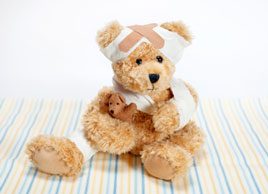Family first-aid essentials
Summer fun is bound to bring on the occasional injury. Be prepared to treat minor cuts, burns and bug bites with these first-aid essentials

Source: Best Health Magazine, Summer 2011
Every year, more than three million Canadians end up in an emergency room because of an injury. These visits are often unnecessary as most of the injuries are preventable, and tend to happen at home where treatments are right at hand. ‘In many cases, seeing a professional for treatment isn’t necessary,’ says Les Johnson, national director of training for St. John Ambulance in Ottawa. ‘And having the right tools at hand can help you look after someone who is hurt.’
Ready-made first-aid kits for your home, cottage or car are available from St. John Ambulance and the Canadian Red Cross. Typically, these don’t include medicines because some people can be sensitive or allergic to them, says Don Marentette, the Winnipeg-based manager of the Red Cross’s first-aid programs. But if your kit is only for your family’and you’re aware of everyone’s health history’then consider including these over-the-counter treatments for some of the most common injuries. (Keep your kit where you can easily check it from time to time to ensure any OTC medications are not out of date.)
For minor cuts and scrapes
EXAMPLES Polysporin Triple Antibiotic Ointment Heal-Fast Formula, Bactroban Ointment, Bioderm First Aid Antibiotic Ointment, Ozonol Non-Stinging Ointment
HOW THEY WORK Topical antibiotic ointments contain one or more antibiotic ingredients’such as zinc, polymyxin B or mupirocin ‘that soothe, treat and protect against minor infections, says Beth McMullen, a pharmacist at Shoppers Drug Mart in Toronto.
NEED TO KNOW Clean the area with soap and water, then apply a thin coating of the ointment. Cover it with a sterile gauze pad, and change this dressing when it becomes dirty or wet (if the wound bleeds through, don’t take off the gauze; just apply more ‘gauze on top so as not to interrupt clotting). If the cut is actively bleeding and can’t be stopped by applying direct pressure, seek immediate medical attention, advises Johnson. See a doctor if you notice signs of infection such as swelling, redness, pain, oozing or pus.
To avoid contamination of the ointment, avoid touching the tube opening to any surface. ‘As soon as your hand touches the opening, you’ll get germs on it, so it’s better to squeeze the formula onto a clean Q-tip or ’tissue, and then apply it to the wound,’ says McMullen. Skip the ointment and use the gauze alone if the injured person has a hypersensitivity to any of the active ingredients.
For minor burns/sunburns
EXAMPLES Aspirin, Advil, Aleve, Tylenol
HOW THEY WORK Each has a different active ingredient’Aspirin has acetylsalicylic acid (ASA), Advil has ibuprofen, Aleve has naproxen sodium and Tylenol has acetaminophen’but all work by temporarily blocking the body’s production of chemical messengers called prostaglandins, which activate pain and fever. This helps reduce the symptoms associated with burns and sunburns.
NEED TO KNOW Due to the risk of Reye’s Syndrome, ASA should never be used to treat pain in children or teens. For adults: With food, take one to two caplets of ASA every four to six hours, one to two tablets of ibuprofen every eight hours, one tablet of naproxen sodium every 12 hours, or one tablet of acetaminophen every four to six hours. But don’t use if the person is pregnant or breastfeeding, takes blood thinners or has asthma, ulcers or a stomach or liver disorder. (Check with a pharmacist for other possible interactions.)
‘Cool down the burn by immersing it in cool water for at least 10 to 20 minutes,’ says Marentette. But don’t immerse it in ice water or apply ice directly; this can cool the skin too quickly, causing further damage. Cover the area with a dry, sterile dressing, and change it no more than once a day. Forget the folk remedy about butter on a burn’it actually seals in the heat. See a doctor if a burn or sunburn blisters, and to avoid infection, never pop the blisters yourself. For those with a sunburn, watch for ‘possible heat stroke and exhaustion, which require immediate medical attention.
For insect stings and minor skin irritations
EXAMPLES Life Calamine Lotion with Antihistamine, Cortoderm Ointment, Original Strength Benadryl Itch Stopping Cream
HOW THEY WORK Life Calamine and Benadryl (which both contain the antihistamine diphenhydramine hydrochloride), as well as Cortoderm (with hydrocortisone), relieve symptoms of local inflammation. Calamine (shake well!) soothes itchiness.
NEED TO KNOW Apply the treatments no more than three to four times daily, but don’t use them on open skin. (A cold pack can also relieve itchiness.) For insect stings, remove the stinger by gently scraping ‘it away with a credit card cleaned with soap and water, says Johnson. Tweezers can make the area more prone to infection and could break the poison sac. ‘Get immediate medical help if there are signs of a severe allergic reaction, such as swelling, hives, rash, nausea or difficulty breathing.
This article was originally titled "Family first-aid essentials" in the Summer 2011 issue of Best Health. Subscribe today to get the full Best Health experience’and never miss an issue!




